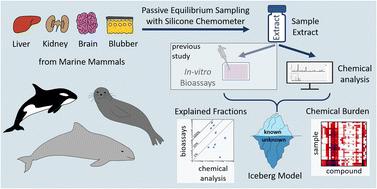当前位置:
X-MOL 学术
›
Environ. Sci.: Processes Impacts
›
论文详情
Our official English website, www.x-mol.net, welcomes your feedback! (Note: you will need to create a separate account there.)
Characterizing the marine mammal exposome by iceberg modeling, linking chemical analysis and in vitro bioassays
Environmental Science: Processes & Impacts ( IF 5.5 ) Pub Date : 2023-05-03 , DOI: 10.1039/d3em00033h Eva B Reiter 1 , Beate I Escher 2, 3 , Elisa Rojo-Nieto 1 , Hannah Nolte 1, 4 , Ursula Siebert 5 , Annika Jahnke 1, 4
Environmental Science: Processes & Impacts ( IF 5.5 ) Pub Date : 2023-05-03 , DOI: 10.1039/d3em00033h Eva B Reiter 1 , Beate I Escher 2, 3 , Elisa Rojo-Nieto 1 , Hannah Nolte 1, 4 , Ursula Siebert 5 , Annika Jahnke 1, 4
Affiliation

|
The present study complements work on mixture effects measured with in vitro bioassays of passive equilibrium sampling extracts using the silicone polydimethylsiloxane (PDMS) in organs from marine mammals with chemical profiling. Blubber, liver, kidney and brain tissues of harbor porpoise (Phocoena phocoena), harbor seal (Phoca vitulina), ringed seal (Phoca hispida) and orca (Orcinus orca) from the North and Baltic Seas were investigated. We analyzed 117 chemicals including legacy and emerging contaminants using gas chromatography-high resolution mass spectrometry and quantified 70 of those chemicals in at least one sample. No systematic differences between the organs were found. Only for single compounds a clear distribution pattern was observed. For example, 4,4′-dichlorodiphenyltrichloroethane, enzacamene and etofenprox were mainly detected in blubber, whereas tonalide and the hexachlorocyclohexanes were more often found in liver. Furthermore, we compared the chemical profiling with the bioanalytical results using an iceberg mixture model, evaluating how much of the biological effect could be explained by the analyzed chemicals. The mixture effect predicted from the quantified chemical concentrations explained 0.014–83% of the aryl hydrocarbon receptor activating effect (AhR-CALUX), but less than 0.13% for the activation of the oxidative stress response (AREc32) and peroxisome-proliferator activated receptor (PPARγ). The quantified chemicals also explained between 0.044–45% of the cytotoxic effect measured with the AhR-CALUX. The largest fraction of the observed effect was explained for the orca, which was the individuum with the highest chemical burden. This study underlines that chemical analysis and bioassays are complementary to comprehensively characterize the mixture exposome of marine mammals.
中文翻译:

通过冰山建模、化学分析和体外生物测定相结合来表征海洋哺乳动物暴露组
本研究补充了通过对海洋哺乳动物器官中的有机硅聚二甲基硅氧烷(PDMS)进行被动平衡取样提取物的体外生物测定并进行化学分析来测量混合物效应的工作。研究人员对来自北海和波罗的海的港鼠海豚 ( Phocoena phocoena )、斑海豹 ( Phoca vitulina )、环斑海豹 ( Phoca hispida ) 和逆戟鲸 ( Orcinus orca ) 的鲸脂、肝脏、肾脏和脑组织进行了研究。我们使用气相色谱-高分辨率质谱分析了 117 种化学物质,包括遗留污染物和新出现的污染物,并对至少一个样品中的 70 种化学物质进行了定量。没有发现器官之间的系统差异。仅对于单一化合物观察到清晰的分布模式。例如,4,4'-二氯二苯基三氯乙烷、恩扎卡烯和醚菊酯主要在鲸脂中检测到,而托纳内酯和六氯环己烷则更常见于肝脏中。此外,我们使用冰山混合物模型将化学分析与生物分析结果进行比较,评估所分析的化学物质可以解释多少生物效应。根据定量化学浓度预测的混合效应解释了芳烃受体激活效应 (AhR-CALUX) 的 0.014-83%,但氧化应激反应 (AREc32) 和过氧化物酶体增殖物激活受体激活的效应不到 0.13%( PPARγ)。量化的化学物质还解释了 AhR-CALUX 测量的 0.044-45% 的细胞毒性效应。所观察到的影响的最大部分是由虎鲸解释的,虎鲸是化学负荷最高的个体。这项研究强调化学分析和生物测定是互补的,可以全面表征海洋哺乳动物的混合物暴露组。
更新日期:2023-05-03
中文翻译:

通过冰山建模、化学分析和体外生物测定相结合来表征海洋哺乳动物暴露组
本研究补充了通过对海洋哺乳动物器官中的有机硅聚二甲基硅氧烷(PDMS)进行被动平衡取样提取物的体外生物测定并进行化学分析来测量混合物效应的工作。研究人员对来自北海和波罗的海的港鼠海豚 ( Phocoena phocoena )、斑海豹 ( Phoca vitulina )、环斑海豹 ( Phoca hispida ) 和逆戟鲸 ( Orcinus orca ) 的鲸脂、肝脏、肾脏和脑组织进行了研究。我们使用气相色谱-高分辨率质谱分析了 117 种化学物质,包括遗留污染物和新出现的污染物,并对至少一个样品中的 70 种化学物质进行了定量。没有发现器官之间的系统差异。仅对于单一化合物观察到清晰的分布模式。例如,4,4'-二氯二苯基三氯乙烷、恩扎卡烯和醚菊酯主要在鲸脂中检测到,而托纳内酯和六氯环己烷则更常见于肝脏中。此外,我们使用冰山混合物模型将化学分析与生物分析结果进行比较,评估所分析的化学物质可以解释多少生物效应。根据定量化学浓度预测的混合效应解释了芳烃受体激活效应 (AhR-CALUX) 的 0.014-83%,但氧化应激反应 (AREc32) 和过氧化物酶体增殖物激活受体激活的效应不到 0.13%( PPARγ)。量化的化学物质还解释了 AhR-CALUX 测量的 0.044-45% 的细胞毒性效应。所观察到的影响的最大部分是由虎鲸解释的,虎鲸是化学负荷最高的个体。这项研究强调化学分析和生物测定是互补的,可以全面表征海洋哺乳动物的混合物暴露组。



























 京公网安备 11010802027423号
京公网安备 11010802027423号